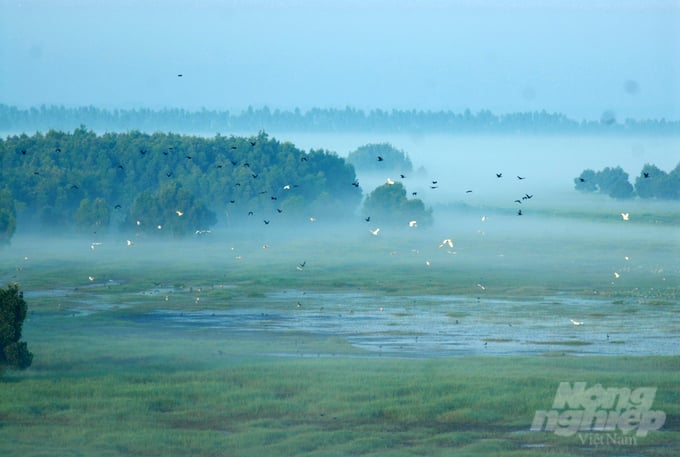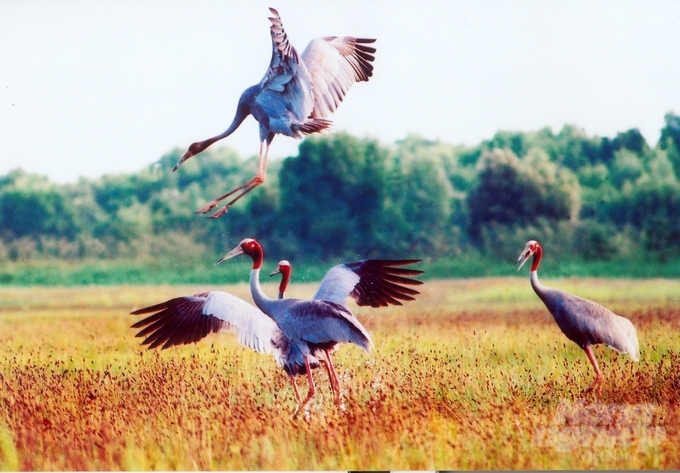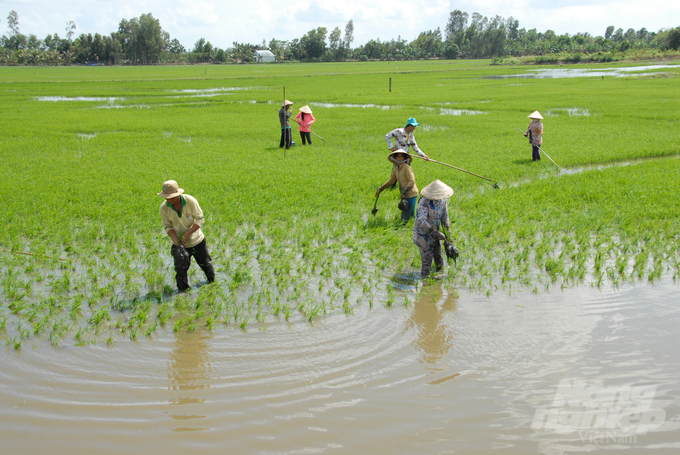November 27, 2025 | 21:53 GMT +7
November 27, 2025 | 21:53 GMT +7
Hotline: 0913.378.918
November 27, 2025 | 21:53 GMT +7
Hotline: 0913.378.918

Tram Chim National Park in Tam Nong District, Dong Thap Province. Photo: Le Hoang Vu.
According to Mr. Nguyen Phuoc Thien, Vice Chairman of Dong Thap Provincial People's Committee, Dong Thap PPC recently signed a memorandum of understanding with the International Crane Foundation (ICF) and the Vietnam Zoo Association (VZA) on the joint conservation of red-crowned crane.
"Two representatives of Tram Chim National Park in Tam Nong district, Dong Thap province are on an important business trip to Thailand. They are tasked with discussing a plan of action to bring Red-crowned to Vietnam in collaboration with the The Zoological Park Organization of Thailand," said Mr. Thien.
The populations of wild red-crowned crane in Vietnam and Cambodia have declined by at least 80% over the last decade. Namely, the total number of red-crowned cranes decreased from 850 in 2010 to less than 160 in the most recent investigation in 2022.
ICF aims to support collaboration on red-crowned crane restoration efforts between Thailand and Vietnam in response to this issue. Additionally, Employees of the Tram Chim National Park will receive technical guidance and training from ICF, VZA, and the Zoological Park Organization of Thailand on raising, releasing, and managing red-crowned cranes' habitats in the core and buffer zones of Tram Chim National Park.

The populations of wild red-crowned crane in Vietnam and Cambodia have declined by at least 80% over the last decade. Namely, the total number of red-crowned cranes decreased from 850 in 2010 to less than 160 in the most recent census in 2022. Photo: Tram Chim National Park.
Depending on demand and availability, the Zoological Park Organization of Thailand will provide Tram Chim National Park with red-crowned crane younglings for rearing and then release into the wild on an annual basis. The safety of the animals, national law, and regulations of the Zoological Park Organization of Thailand are all taken into consideration during this process.
Dong Thap province has designated area A4 in Tram Chim National Park as a free range red-crowned crane zone. This area is surrounded by a 1,623-hectare buffer zone, where rice will be produced organically without the traditional use of chemical fertilizers. While waiting for the red-crowned crane from Thailand, Tram Chim National Park is renovating its natural ecological environment so that the cranes can adapt and stay permanently.
Mr. Nguyen Phuoc Thien recently had a meeting with the Tam Nong district People's Committee and Tram Chim National Park to discuss the progress of the organic rice production model in the designated area. There are 275 agriculturally active households in the area, the majority of which are located in Phu Duc and Tan Cong Sinh communes that border area A4 in Tram Chim National Park.

Depending on demand and availability, the Zoological Park Organization of Thailand will provide Tram Chim National Park with red-crowned crane chicks for rearing and release into the wild on an annual basis. Photo: Le Hoang Vu.
The local government has mobilized and guided farmers to produce rice organically; thereby, gradually reduce the amount of chemical fertilizers used in 4 consecutive crops. Rice farmers are trained in environmentally friendly rice production, cluster seeders utilization to reduce seeds, rice brand establishment, organic rice certification from the fourth year, trade promotion and other activities.
The model will be implemented over the course of three phases between 2023 and 2025, covering a total area of 200 hectares and costing over 13.6 billion VND. Fifteen households have been mobilized to register for organic rice production on nearly 100 hectares of 2023 summer-autumn crop in the buffer zone surroundng area A4. These activities will help to create an ecological environment suitable for the growth of red-crowned cranes.
According to Mr. Thien, the local government is accelerating the process of ground leveling in combination with the burning of vegetation and natural environment improvement to create optimal ecological conditions for the long-term development of red-crowned cranes.

Dong Thap province has designated area A4 in Tram Chim National Park as a free range red-crowned crane zone. This area is surrounded by a 1,623-hectare buffer zone, where rice will be produced organically. Photo: Le Hoang Vu.
Dong Thap Provincial People's Committee advised concerned parties to invite Thai specialists to Dong Thap to offer their input on the design of the crane free range area. On the other hand, parties are recommended to complete the necessary legal procedures to promptly implement the project on the conservation and development of red-crowned cranes.
“The local government must help farmers realize that organic rice production is highly beneficial, preventing reliance on the Government. All activities must be done synchronously, without hesitation otherwise we will miss our opportunities", emphasized Mr. Nguyen Phuoc Thien.
Translated by Nguyen Hai Long

(VAN) According to Mr. Vo Minh Thanh, Director of the Tay Ninh Department of Agriculture and Environment, Resolution 57 has created a new development pathway for the locality, shifting from traditional toward modern agriculture.
/2025/11/26/4909-2-154329_878.jpg)
(VAN) Pearl grouper farming in HDPE cages not only delivers economic efficiency but also contributes to protecting the environment, creating jobs, and promoting marine-based experiential tourism.

(VAN) The model of making a living under the forest canopy through the agroforestry system in Van Son commune, Bac Ninh province, is expected to generate an annual income of approximately VND 30 million/ha.

(VAN) Many enterprises in Can Tho are harnessing natural energy and reducing greenhouse gas emissions in their production processes, thereby contributing to the promotion of a sustainable green transition.
/2025/11/24/3536-2-112800_176.jpg)
(VAN) Dong Nai now has tens of thousands of hectares of forests certified for sustainable management, and this area will continue to be expanded in the coming period.

(VAN) Vinh Ha hamlet (Dai Xuyen commune, Hanoi) is shifting away from small-scale farming as households adopt bioscurity into their breeder chicken models.

(VAN) Heavy rains make aquatic species more vulnerable to disease. Proactive water management and high-tech systems help farmers prevent outbreaks and protect yields.